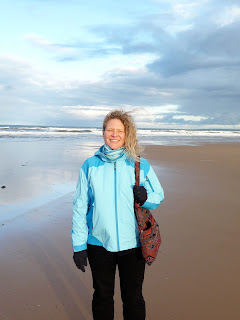--in case you did not appreciate the intensity of my feeling--October Holiday ROCKS! really. It ranks up there with the 20-minute coffee break and one-hour lunch break of my daily life. Return to normalcy does not sound appealing from this perspective.
I learned today, that the October holiday used to be called the Tatie Holiday. (Tatie is the local word for potato).
In days not that long gone by, this was a holiday from school so that pupils could earn a few shillings by helping to bring in the potato crop.
Okay, back to Orkney...which, according to my friend Dewitt, is a funny sounding name. I will blog another time on the delights of the town names in Scotland. . .
Orkney is an island north of Scotland. It is actually made up of some 70 islands. The "mainland," confusing, I know, is Orkney. Seventeen islands, I think, are uninhabited. There is some 5500 years of history on these islands--living and farming! They were once a Norwegian colony. The Vikings played a huge role in their history. The neolithic sights are amazing...but here the histories overlap so beautifully. There is Viking graffiti marks left in some of the neolithic sites..
People have not changed much, by the way...some of the graffiti is just about a beautiful women left behind, another was a quick picture of a dragon, another is bragging about being the best ruin writer! The fact that I got to see these markings with my own eyes, was pretty amazing...even more so, that I was standing in a neolithic tomb at the time.
So, yea, Orkney...I loved every moment.
 |
| Lots of water and boating history associated with an island, not surprisingly. This is from a small dock in
Stromness.
|
 |
| I found that the constant of the water was very appealing to me. I feel
a contentment and peace looking out over the surf.
|
 |
| Thistle and field grass near the Ring of Brodgar |
 |
| One of the standing stones at the Ring of Brodgar, a large and impressive
henge.
|
 |
| These are standing stones at the Ring of Stenness. |
 |
| This is a similar, but less developed site than the one at Skara Brae. This is site is called Barnhouse. |
 |
| Closer |
 |
| Interior |
 |
| Exterior |
 |
| Deliberately sunken ships in Scapa Flow |
 |
| Building Materials and the foundation of the Churchill Barriers. The signs
before you cross warn that you do so at your own danger.
|
 |
| Close up |
 |
| This is a neolithic dove cot (pronounced doo coh). There are still doves
living inside.
|
 |
| Closer |
 |
| Interior |
 |
| The Cairn of Unstan |
 |
| Interior looking out |
 |
| I had to walk with my butt on my heels to get through
the low passage. I am inside the close passage here.
|
I was introduced to the writer and poet George MacKay Brown.
Here is one of his poems:
A Work for Poets
| To have carved on the days of our vanity A sun A ship A star A cornstalk Also a few marks From an ancient forgotten time A child may read That not far from the stone A well Might open for wayfarers Here is a work for poets - Carve the runes Then be content with silence. |
North Ronaldsay sheep only eat seaweed. They are virtually fat free. I ate lamb while on island--and it was delicious--but I do not know if it was of the seaweed variety.
On the mainland Island (love the irony of this) of Orkney there is a parish named Harray. In this parish there is a man who creates pottery. Wait for it...
He calls his shop Harray Potter.
I was surveyed at the dock before my ferry departed. In the pleasant conversation, I was informed that Orkney has two seasons: 9 months of winter and three months of severe weather. But I think he was exaggerating a bit.
I think that I am a bit enamored of the island and will return, at the very least to see the puffins who nest there in the early part of summer.
And I treated myself to this little gift. The colors and shapes reminds me of the light and water of my holiday in Orkney.

































